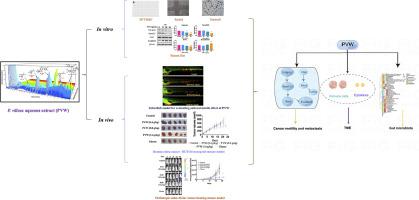Phytomedicine ( IF 6.7 ) Pub Date : 2023-05-30 , DOI: 10.1016/j.phymed.2023.154900 Huihai Yang 1 , Grace Gar-Lee Yue 1 , Ka-Ki Yuen 1 , Si Gao 1 , Ping Chung Leung 1 , Chun Kwok Wong 2 , Clara Bik-San Lau 1

|
Background
Patrinia villosa, a traditional medicinal herb commonly used for treating intestinal-related diseases, has been commonly prescribed by Chinese medicine practitioners as a key component herb to treat colon cancer, although its anti-tumor effect and mechanisms of action have not been fully elucidated.
Hypothesis/purpose
This study aimed to investigate the anti-tumor and anti-metastatic effects of Patrinia villosa aqueous extract (PVW), and its underlying mechanisms.
Method
The chemical profile of PVW was analysed by high-performance liquid chromatography with photodiode-array detection (HPLC-DAD) method. Cell-based functional assays MTT, BrdU, scratch, and transwell were conducted to evaluate the effects of PVW on human colon cancer HCT116 and murine colon26-luc cells, assessing cytotoxicity, cell proliferation, motility, and migration, respectively. Western blotting was performed to assess the effect of PVW on the expression of key intracellular signaling proteins. In vivo studies were conducted using zebrafish embryos and tumor-bearing mice to evaluate the anti-tumor, anti-angiogenesis, and anti-metastatic effects of PVW in colon cancer.
Results
Five chemical markers were identified and quantified in PVW. PVW exhibited significant cytotoxicity and anti-proliferative activity, as well as inhibitory effects on cell motility and migration in both HCT116 and colon 26-luc cancer cells via modulating protein expressions of TGF-β R1, smad2/3, snail, E-cadherin, FAK, RhoA, and cofilin. PVW (0.01–0.1 mg/ml) could significantly decrease the length of subintestinal vessels of zebrafish embryos through decreasing mRNA expressions of FLT1, FLT4, KDRL, VEGFaa, VEGFc, and Tie1. PVW (> 0.05 mg/ml) also significantly suppressed colon cancer cells migration in the zebrafish embryos. Furthermore, oral administration of PVW (1.6 g/kg) significantly inhibited tumor growth by decreasing the expressions of tumor activation marker Ki-67 and CD 31 in tumor tissues of HCT116 tumor-bearing mice. PVW could also significantly inhibit lung metastasis in colon 26-luc tumor-bearing mice by modulating their tumor microenvironment, including immune cells populations (T cells and MDSCs), levels of cytokines (IL-2, IL-12, and IFN-γ), as well as increasing the relative abundance of gut microbiota.
Conclusion
This study revealed for the first time the anti-tumor and anti-metastatic effects of PVW through regulation of TGF-β-smad2/3-E-cadherin, and FAK-cofilin pathways in colon cancer. These findings provide scientific evidence to support the clinical use of P. villosa in patients with colon cancer.
中文翻译:

通过调节 TGF-β R1-smad2/3-E-钙粘蛋白和 FAK-RhoA-cofilin 通路,深入了解毛败酱水提取物对结肠癌的抗肿瘤和抗转移作用
背景
败酱是一种常用于治疗肠道相关疾病的传统药材,虽然其抗肿瘤作用和作用机制尚未完全阐明,但已被中医作为治疗结肠癌的关键成分草药。
假设/目的
本研究旨在探讨败酱草水提取物(PVW)的抗肿瘤和抗转移作用及其潜在机制。
方法
通过光电二极管阵列检测高效液相色谱 (HPLC-DAD) 方法对 PVW 的化学成分进行了分析。进行基于细胞的功能测定 MTT、BrdU、scratch 和 transwell,以评估 PVW 对人结肠癌 HCT116 和小鼠 colon26-luc 细胞的影响,分别评估细胞毒性、细胞增殖、运动和迁移。进行蛋白质印迹以评估 PVW 对关键细胞内信号蛋白表达的影响。使用斑马鱼胚胎和荷瘤小鼠进行体内研究,以评估 PVW 在结肠癌中的抗肿瘤、抗血管生成和抗转移作用。
结果
PVW 中鉴定并量化了五种化学标记物。PVW 通过调节 TGF-β R1、smad2/3、snail、E-cadherin、 FAK、RhoA 和 cofilin。PVW (0.01–0.1 mg/ml) 可以通过降低 FLT1、FLT4、KDRL、VEGFaa、VEGFc 和 Tie1 的 mRNA 表达来显着缩短斑马鱼胚胎肠下血管的长度。PVW (> 0.05 mg/ml) 还显着抑制斑马鱼胚胎中结肠癌细胞的迁移。此外,口服PVW(1.6 g/kg)通过降低HCT116荷瘤小鼠肿瘤组织中肿瘤激活标志物Ki-67和CD 31的表达来显着抑制肿瘤生长。
结论
这项研究首次揭示了PVW通过调节结肠癌中的TGF-β-smad2/3-E-cadherin和FAK-cofilin通路来发挥抗肿瘤和抗转移作用。这些发现为支持长毛 P. villosa在结肠癌患者中的临床应用提供了科学证据。











































 京公网安备 11010802027423号
京公网安备 11010802027423号